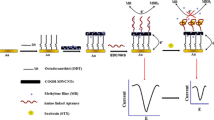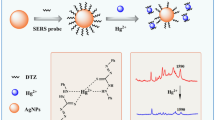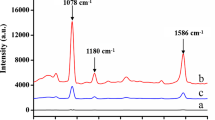Abstract
Saxitoxin (STX) as one of the most harmful and typical paralytic shellfish toxins, is posing a serious threat to environmental and human health, thus it is essential to develop a sensitive and reliable analytical method for STX detection. Herein, we proposed a strategy for rapid and sensitive detection of STX with surface-enhanced Raman spectroscopy (SERS), by employing cysteine modified gold nanoparticles (Cys-AuNPs) as SERS probe to capture STX molecules through electrostatic interactions and multiple hydrogen bonds between Cys and STX molecules. Moreover, the XPS and zeta potential results indicated that Cys could bond to AuNPs through Au-S bonds and the addition of STX could induce the efficient aggregation of Cys-AuNPs owing to the presence of electrostatic interactions and multiple hydrogen bonds between Cys and STX molecules. Furthermore, considering the high sensitivity and stability of the dynamic surface-enhanced Raman spectroscopy (D-SERS) strategy with the formation of a 3D hotspot matrix, the highly sensitive detection of STX was realized to a level of 1 × 10−7 M by using the D-SERS strategy. Consequently, Cys-AuNPs as high affinity substrates can provide high sensitivity for the detection of STX through the D-SERS strategy.

Graphical abstract




Similar content being viewed by others
References
Sellner KG, Doucette GJ, Kirkpatrick GJ. Harmful algal blooms: causes, impacts and detection. J Ind Microbiol Biotechnol. 2003;30(7):383–406.
Gao S, Zheng X, Wu J. A biolayer interferometry-based competitive biosensor for rapid and sensitive detection of saxitoxin. Sensors Actuators B Chem. 2017;246:169–74.
Cusick KD, Sayler GS. An overview on the marine neurotoxin, saxitoxin: genetics, molecular targets, methods of detection and ecological functions. Mar Drugs. 2013;11(4):991–1018.
Pearman WF, Angel SM, Ferry JL, Hall S. Characterization of the Ag mediated surface-enhanced Raman spectroscopy of Saxitoxin. Appl Spectrosc. 2008;62(7):727–32.
Humpage AR, Magalhaes VF, Froscio SM. Comparison of analytical tools and biological assays for detection of paralytic shellfish poisoning toxins. Anal Bioanal Chem. 2010;397(5):1655–71.
Park DL, Adams WN, Graham SL, Jackson RC. Variability of mouse bioassay for determination of paralytic shellfish poisoning toxins. J Assoc Off Anal Chem. 1986;69(3):547–50.
Usleber E, Dietrich R, Btrick C, et al. Immunoassay methods for paralytic shellfish poisoning toxins. J AOAC Int. 2001;84(5):1649–56.
Bragg WA, Lemire SW, Coleman RM, Hamelin EI, Johnson RC. Detection of human exposure to saxitoxin and neosaxitoxin in urine by online-solid phase extraction-liquid chromatography-tandem mass spectrometry. Toxicon. 2015;99:118–24.
Lawrence JF, Niedzwiadek B, Menard C. Quantitative determination of paralytic shellfish poisoning toxins in shellfish using prechromatographic oxidation and liquid chromatography with fluorescence detection: collaborative study. J AOAC Int. 2005;88(6):1714–32.
Peng RY, Si YM, Deng T, Zheng J, Li JS, Yang RH, et al. A novel SERS nanoprobe for the ratiometric imaging of hydrogen peroxide in living cells. Chem Commun. 2016;52(55):8553–6.
Li DW, Qu LL, Hu K, Long YT, Tian H. Monitoring of endogenous hydrogen Sulfide in living cells using surface-enhanced Raman scattering. Angew Chem Int Ed. 2015;54(43):12758–61.
Han C, Yao Y, Wang W, Qu L, Bradley L, Sun S, et al. Rapid and sensitive detection of sodium saccharin in soft drinks by silver nanorod array SERS substrates. Sensors Actuators B Chem. 2017;251:272–9.
He H, Li P, Tang XH, Lin DY, Xie AJ, Shen YH, et al. Developing cysteamine-modified SERS substrate for detection of acidic pigment with weak surface affinity. Spectrochim Acta Pt A. 2019;212:293–9.
Yu BR, Ge MH, Li P, Xie QW, Yang LB. Development of surface-enhanced Raman spectroscopy application for determination of illicit drugs: towards a practical sensor. Talanta. 2019;191:1–10.
Li XH, Chen GY, Yang LB, Jin Z, Liu JH. Multifunctional au-coated TiO2 nanotube arrays as recyclable SERS substrates for multifold organic pollutants detection. Adv Funct Mater. 2010;20(17):2815–24.
Alvarez-Puebla RA, Liz-Marzan LM. SERS detection of small inorganic molecules and ions. Angew Chem Int Ed. 2012;51(45):11214–23.
Cao XM, Qin M, Li P, Zhou BB, Tang XH, Ge MH, et al. Probing catecholamine neurotransmitters based on iron-coordination surface-enhanced resonance Raman spectroscopy label. Sensors Actuators B Chem. 2018;268:350–8.
Li JY, Hu XY, Zhou YR, Zhang L, Ge ZP, Wang XR, et al. β-Cyclodextrin-Stabilized Au Nanoparticles for the Detection of Butyl Benzyl Phthalate. ACS Appl Nano Mat. 2019;2:2743–51.
Li Q, Lu ZC, Tan XC, Xiao XY, Wang P, Wu L, et al. Ultrasensitive detection of aflatoxin B-1 by SERS aptasensor based on exonuclease-assisted recycling amplification. Biosens Bioelectron. 2017;97:59–64.
Cheng S, Zheng B, Yao DB, Wang Y, Tian JJ, Liu LH, et al. Determination of Saxitoxin by Aptamer-based surface-enhanced Raman scattering. Anal Lett. 2019;52(6):902–18.
Cheng S, Zheng B, Yao DB, Kuai SL, Tian JJ, Liang HJ, et al. Study of the binding way between saxitoxin and its aptamer and a fluorescent aptasensor for detection of saxitoxin. Spectrochim Acta Pt A. 2018;204:180–7.
Yang LB, Li P, Liu HL, Tang XH, Liu JH. A dynamic surface enhanced Raman spectroscopy method for ultra-sensitive detection: from the wet state to the dry state. Chem Soc Rev. 2015;44(10):2837–48.
Liu HL, Yang ZL, Meng LY, Sun YD, Wang J, Yang LB, et al. Three-dimensional and time-ordered surface-enhanced Raman scattering hotspot matrix. J Am Chem Soc. 2014;136(14):5332–41.
Frens G. Controlled nucleation for the regulation of the particle size in monodisperse gold suspensions. Nature Phys Sci. 1973;241(105):20–2.
Haiss W, Thanh NT, Aveyard J, Fernig DG. Determination of size and concentration of gold nanoparticles from UV-vis spectra. Anal Chem. 2007;79(11):4215–21.
Tian L, Su MK, Yu FF, Xu Y, Li XY, Li L, et al. Liquid-state quantitative SERS analyzer on self-ordered metal liquid-like plasmonic arrays. Nat Commun. 2018;9:3642.
Schlenoff JB, Li M, Ly H. Stability and self-exchange in Alkanethiol monolayers. J Am Chem Soc. 1995;117(50):12528–36.
Ishida T, Hara M, Kojima I, Tsuneda S, Nishida N, Sasabe H, et al. High resolution X-ray photoelectron spectroscopy measurements of Octadecanethiol self-assembled monolayers on au(111). Langmuir. 1998;14(8):2092–6.
Mezour MA. Perepichka, ii, Ivasenko O, Lennox RB, Perepichka DF. Tridentate benzylthiols on au(111): control of self-assembly geometry. Nanoscale. 2015;7(11):5014–22.
Atar N, Eren T, Demirdögen B, Yola ML. ağlayan MO. Silver, gold, and silver@gold nanoparticle-anchored l-cysteine-functionalized reduced graphene oxide as electrocatalyst for methanol oxidation. Ionics. 2015;21(8):2285–93.
Mikhlin Y, Likhatski M, Tomashevich Y, Romanchenko A, Erenburg S, Trubina S. XAS and XPS examination of the au–S nanostructures produced via the reduction of aqueous gold (III) by sulfide ions. J Electron Spectrosc Relat Phenom. 2010;177(1):24–9.
Ndokoye P, Ke J, Liu J, Zhao Q, Li X. L-cysteine-modified gold nanostars for SERS-based copper ions detection in aqueous media. Langmuir. 2014;30(44):13491–7.
Kühnle A, Linderoth TR, Schunack M, Besenbacher F. L-cysteine adsorption structures on au(111) investigated by scanning Tunneling microscopy under ultrahigh vacuum conditions. Langmuir. 2006;22(5):2156–60.
Beerbom MM, Gargagliano R, Schlaf R. Determination of the electronic structure of self-assembled L-cysteine/au interfaces using photoemission spectroscopy. Langmuir. 2005;21(8):3551–8.
Yang LB, Liu HL, Ma YM, Liu JH. Solvent-induced hot spot switch on silver nanorod enhanced Raman spectroscopy. Analyst. 2012;137(7):1547–9.
Ge MH, Li P, Cao CT, Li SF, Lin DY, Yang LB. A long-period and high-stability three-dimensional surface-enhanced Raman scattering hotspot matrix. Chem Commun. 2019;55(59):8647–50.
Alfonso A, Louzao MC, Vieytes MR, et al. Comparative study of the stability of saxitoxin and neosaxitoxin in acidic solutions and lyophilized samples. Toxicon. 1994;32(12):1593–8.
Dasary SS, Singh AK, Senapati D, Yu H, Ray PC. Gold nanoparticle based label-free SERS probe for ultrasensitive and selective detection of trinitrotoluene. J Am Chem Soc. 2009;131(38):13806–12.
López-Tobar E, Hernández B, Ghomi M, Sanchez-Cortes S. Stability of the Disulfide bond in Cystine adsorbed on silver and gold nanoparticles as evidenced by SERS data. J Phys Chem C. 2013;117(3):1531–7.
Panikar SS, Ramirez-Garcia G, Sidhik S, Lopez-Luke T, Rodriguez-Gonzalez C, Ciapara IH, et al. Ultrasensitive SERS substrate for label-free therapeutic-drug monitoring of paclitaxel and cyclophosphamide in blood serum. Anal Chem. 2019;91(3):2100–11.
Pawlukojc A, Leciejewicz J, Ramirez-Cuesta AJ, Nowicka-Scheibe J. L-cysteine: neutron spectroscopy, Raman, IR and ab initio study. Spectrochim Acta Pt A. 2005;61:2474–81.
Huai QY, Gao CL, Miao JL, Yao HL, Wang ZL. Fast detection of saxitoxin using laser tweezers surface enhanced Raman spectroscopy. Anal Methods. 2013;5(23):6870–3.
Olson TY, Schwartzberg AM, Liu JL, Zhang JZ. Raman and surface-enhanced Raman detection of Domoic acid and Saxitoxin. Appl Spectrosc. 2011;65(2):159–64.
Fleger Y, Mastai Y, Rosenbluh M, Dressler DH. SERS as a probe for adsorbate orientation on silver nanoclusters. J Raman Spectrosc. 2009;40(11):1572–7.
Li P, Liu HL, Yang LB, Liu JH. The time-resolved D-SERS vibrational spectra of pesticide thiram. Talanta. 2013;117:39–44.
Turley HK, Hu ZW, Jensen L, Camden JP. Surface-enhanced resonance hyper-Raman scattering elucidates the molecular orientation of Rhodamine 6G on silver colloids. J Phys Chem Lett. 2017;8(8):1819–23.
Acknowledgements
This work is supported by the National Major Scientific and Technological Special Project for “Significant New Drugs Development” (No.2018ZX09J18112), the National Science Foundation of China (61875206), CASHIPS Director′s Fund (YZJJ2019QN13), the Sci-tech Police Project of Anhui Province (806116381020 and 904038287034).
Author information
Authors and Affiliations
Corresponding authors
Ethics declarations
Conflict of interest
There are no conflicts to declare.
Additional information
Publisher’s note
Springer Nature remains neutral with regard to jurisdictional claims in published maps and institutional affiliations.
Electronic supplementary material
ESM 1
(PDF 1.05 mb)
Rights and permissions
About this article
Cite this article
Cao, C., Li, P., Liao, H. et al. Cys-functionalized AuNP substrates for improved sensing of the marine toxin STX by dynamic surface-enhanced Raman spectroscopy. Anal Bioanal Chem 412, 4609–4617 (2020). https://doi.org/10.1007/s00216-020-02710-9
Received:
Revised:
Accepted:
Published:
Issue Date:
DOI: https://doi.org/10.1007/s00216-020-02710-9




